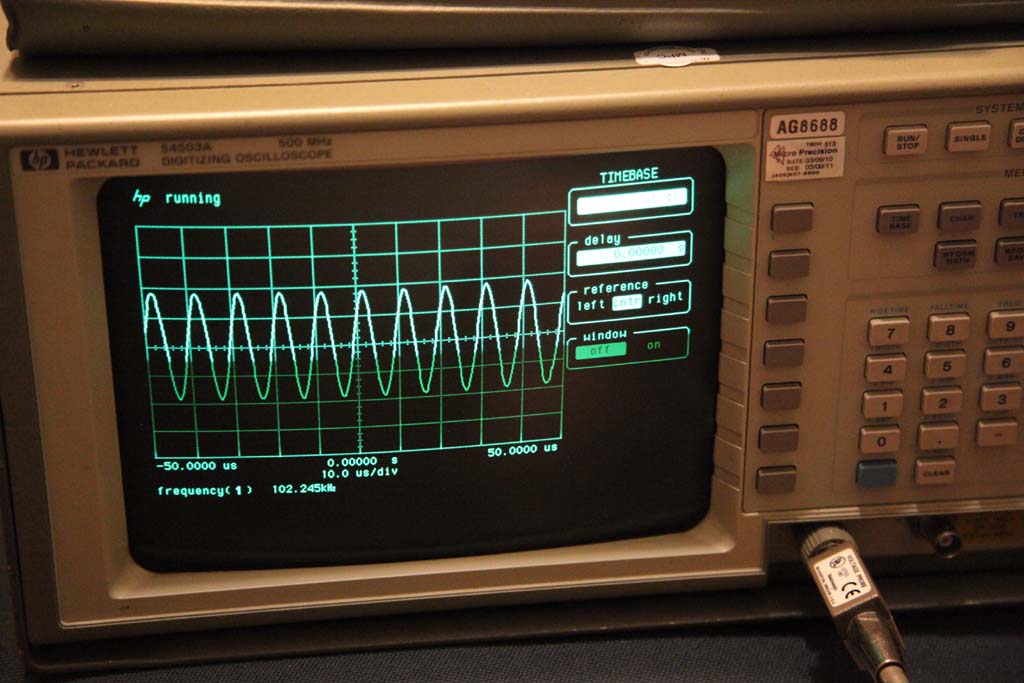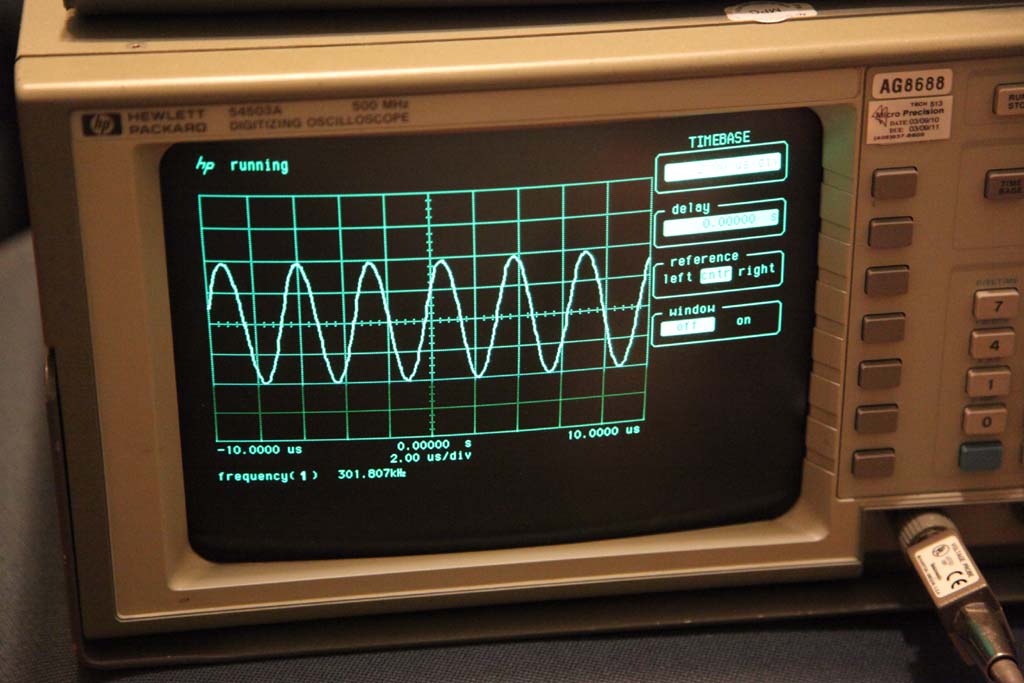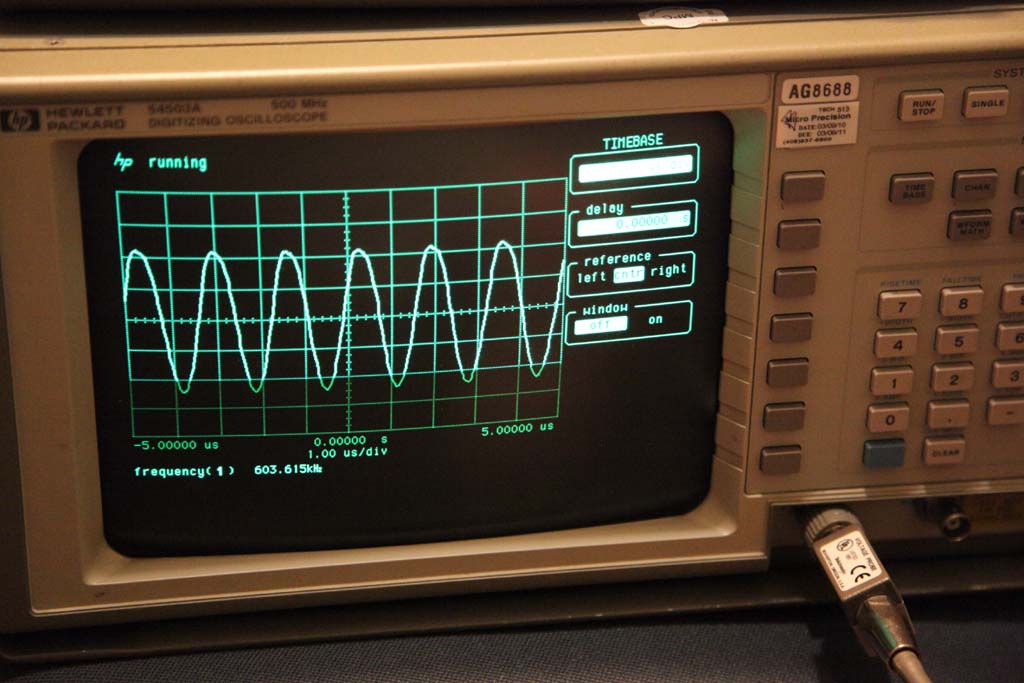Starting on the HP200CD oscilaltor
Posts: 15,286
Threads: 531
Joined: Oct 2011
City: Jackson, NJ
S'more:
100kHz

300kHz

600kHz. This is where distortion starts creeping in (who cares, It is RF)

---------
And the frequency is pretty much accurate, what you set is more or less is what you get.
(This post was last modified: 03-08-2014, 09:25 PM by morzh.)
Posts: 1,106
Threads: 88
Joined: Jun 2011
City: Tacoma
State, Province, Country: Washington
Is it just me, or do ALL the digitizing scopes have that 'grass' on the trace? A scope shouldn't have that. I just got in a Tektronix TDS 540B and it has that as well, along with a bunch of other problems. I'm very disappointed in it.. was hoping for a good scope to use on UHF ham gear. Now I'll have to go back to my 200 MHz analog scope.
Posts: 1,113
Threads: 14
Joined: Feb 2013
City: Irvington, NY
Its the nature of the beast. All digital scopes store the trace as sequence of discrete voltage levels so you get the steps in the trace. If the A/D converter uses more bits for the conversion, the steps get smaller but are always there (quantization error). The raster scan display also contributes as there are a fixed number of pixels available horizontally so you have to display points on the screen in discrete steps. I guess the "bumpy" traces don't bother younger users as they are used to the digital type of display.
Personally, I love the clean waveform display of a good analog scope. I will continue using my older Tek scopes. The ones from the 60's and 70's are my favorites for trace image quality.
(This post was last modified: 03-09-2014, 09:47 AM by Mondial.)
Posts: 15,286
Threads: 531
Joined: Oct 2011
City: Jackson, NJ
Guys
This is, first of all, a crappy scope. Its sampling rate is 20Ms at claimed bandwidth of 500MHZ. Which means that even if amp bandwidth should be adequate A/D converter is not.
At work while in Telecom I had a 16GHz 4 channel Tek with full software (eye analysis, all hystograms etc) - you should see the waveform, it is beautiful.
I also have a 1GHz GP Tek scope at work now, bought it 2 years ago, also a great scope. But then this HP is from 80s - it is about 30 years old.
I do not see todays good digital scopes being any worse the analog. If anything they are better. Their brightness is no longer dependent on the time base as it was the case with all analogs, and of course triggering is vastly superior so this hideous memory phosphorus that was in analog memory scopes is no longer needed. I grew up with analog scopes but once I tried a good digital one, I switched in a jiffy, no nostalgia at all.
Posts: 15,286
Threads: 531
Joined: Oct 2011
City: Jackson, NJ
Well, I decided to put the case back and leave it for a while; I spoke to a friend of mine while running in and monitoring the signal when after about 40 minutes I started noticing a distortion which manifested itself as one slope being much faster and one top looking a bit flattish.
I cooled it off, it started normally and then progressed to flattening one top again;
Changing the output tubes (they are followers) resulted in reversal of the flattened peaks.
I thought of maybe buying another 6AU5GT tube but both tested at leat twice the value shown in the chart (one required me to go to 15000 scale whereas the value should be about 2,900 for new tube).
In any case I decided to check voltages and I noticed the voltage is low, being 120V whereit calles for 190V (B+), and input being 160V whereas it says it should be 215V (the first filter cap). The ripple looks reasonable.
Also plate voltage at the output should be 165V and at 110VAC input it is 85V, at 120VAC it is 95V.
Then I looked at the sch and noticed this: the sch calls for 5AR4 tube for the rectifier.
The actually installed tube is 5Y3GT.
But the marking on the actual chassis for V5 tube is also 5Y3GT.
I know 5AR4 is about 40% more current capable tube with less resistance and indirect heated cathode, so in part the low voltage could be explained by it, but then obviously they did use 5Y3 tube if it is printed on the chassis.
This is interesting. Anyone has experience with HPs and their performance?
I could leave it the way it is but somehow I think I want to straighten this out.
Posts: 1,113
Threads: 14
Joined: Feb 2013
City: Irvington, NY
Did you change the two paper coupling caps? These leak badly when they get warm and throw off the bias on the output tubes.
These are the two plastic molded caps with the colored stripes. They are invariably bad as any other 60 year old paper cap.
Posts: 15,286
Threads: 531
Joined: Oct 2011
City: Jackson, NJ
You mean C8 and C9 0.05uF? No, I did not change any caps other than electrolytics.
I will as now I am willing to see what causes it. I thought 50s paper caps are better than 30s paper caps....though I have read there is some chemical thing that happens to paper that makes all of them bad at some point.
You mean those two cylindrical really cool-looking beautiful caps? It's a pity to tak them out 
I would still like to know what the deal is with voltages and the rectifier tube though.
(This post was last modified: 03-09-2014, 03:37 PM by morzh.)
Posts: 1,113
Threads: 14
Joined: Feb 2013
City: Irvington, NY
Yes those are the ones. They are pretty but are always leaky. As bad or worse than the waxed paper caps of the 30's and 40's.
Anytime you see those stripes you know there will be trouble. They are known as "bumble bees". Sprague made them from the late 40's to late 50's.
Later Sprague made similar looking caps with Mylar dielectric, but they printed the value on them instead of the color code. These are typically still good 50 years later.
The power supply voltage might be low because the output tubes are drawing excessive current, due to the positive leakage reducing the negative grid bias.
Posts: 15,286
Threads: 531
Joined: Oct 2011
City: Jackson, NJ
Well, couple of things...
1. I replace the Bumble-bees (which I think were leaky, you are right Mondial) with 0.047uF 400V I had in stock, conveniently in qty of 2, the film type.
2. The voltages indeed became exactly as the chart says.
3. Now while before the oscillation became distorted some, it would continue oscillating. Now the oscilation lasts about 2-3 minutes, after that the saturation occurs on one side, and then the amplitude start decreasing very rapidly and within 10-15 seconds after that the oscillation is gone.
As before the saturating side swaps with the output tubes.
I suspect the higher plate voltage simply makes the tube fail faster, this is why.
You think one of them tubes is bad? I never checked for gas......
BTW even without load the output tubes run quite hot.
PS. Checked for gas, both are OK.
The tubes are 6AV5, not 6AU5 (both could be installed)
One tests 7500, another about 8200 uMho.
(This post was last modified: 03-09-2014, 04:53 PM by morzh.)
Posts: 1,113
Threads: 14
Joined: Feb 2013
City: Irvington, NY
Yes, one of the output tubes might be gassy, which causes it to conduct more as it warms up. The fact that the distortion switches polarity when you reverse the output tubes seems to confirm this.
You could also try switching the 6SH7 tubes just to eliminate them as a cause.
Posts: 15,286
Threads: 531
Joined: Oct 2011
City: Jackson, NJ
I did, when I first started swapping tubes I swapped all. 6SH7 did not have any effect.
Also one thing: the chassis says 6AU5GT or 6AV5GA. I have 6AV5GT. Which are the same electrically but are in the smaller envelope I believe than GA.
I think I go buy a pair of either one recommended on the chassis and give it a try.
PS. Bought 6AU5GT, with shipping about 4 bucks a tube BIN.
(This post was last modified: 03-09-2014, 07:04 PM by morzh.)
Posts: 15,286
Threads: 531
Joined: Oct 2011
City: Jackson, NJ
OK, update.
Today 6AU5GT came, bought 4, all NOS.
First I duplicated the oscilaltion die-out, to make sure I still have it.
At the same time I put the voltmeter on the B+ to monitor it.
In about 3 minutes one of the wavecrests started to flatten, I looked at the B+, it was going down. From 195V it gradually got down to below 160V and this is where it really falttened and I turned it off.
Then I replaced one tube (I had 6AV5GAs there) with 6AU5.
Same story happened again.
So I replaced the second tube and started watching.
Once the oscillation started the B+ as expected started going down a bit, got to 193V and then climbed back to 195.5V. The osciullation was stable.
I waited about a couple of minutes, and got the marker to mark the last 6AV5 tube I replaced as bad. At the same time I noticed the B+ started dropping. It kept dropping, when at about 186V I noticed one of the wave crests starting to flatten. My mood fell through the floor all the way down the sewer, and the voltage kept falling until it reached 181V. The lower crest had flattened noticeably now, about 10% when the dropping stopped, and the voltage started very slowly climbing back. When it reached 185V the lower amplitgude got back to normal, abd the voltage kept climbing. It climbed very slowly to 195V, over a few minutes. Now as I am writing this it is sitting at 197.6V and still going up very slowly.
I am not sure what this could be. I even thought of electrolytic capacitors as I reformed them and did not replace. But the DC was very clean when I looked at it before, so I doubt it is them.
I am puzzled but no it is working fine and I am gonna take it.
I will probably try to reinstall the old tubes one more time to see if something happened to the power somehow, but....
Dunno.
In any event it seems to work now.
---
More.
Pulled one of the new tubes and inserted one of the old ones, the one that I replaced first without any result.
For a while it worked normally, then over 5 or so minutes the voltage dropped to 175V at which point the amplitude was 2/3 of initial but the signal was symmetrical and looking good.
Then I replaced it with the second old tube, and the initial scenaro repeated itself, when the oscilaltion got distorted fast and the voltage dropped also fast.
I am back to the new tubes, seems stable.
PS. The output tubes run very hot, you cannot touch the base, it is hot so I have to use something wrapped over it to pull it.
Don't know if thios is normal for these, I have no experience with this kind.
PPS. Not even sure the tube is bad. Could be some incompatibility. I am sure irt could work in another device.
But here's using tube tester for you - it tests absolutely normal, same uMhos as the other tubes and no gas.
PPPS. The oscillator is still running on the new 6AU5GT tubes and the B+ is very stable at about 196.5V (should be 190V but then is at 115V).
(This post was last modified: 03-14-2014, 07:30 PM by morzh.)
Posts: 1,113
Threads: 14
Joined: Feb 2013
City: Irvington, NY
Those tubes run very hot. The glass envelope is very small and the plate structure is very close to it. Even the filament itself dissipates about 7.5 watts, so there is a lot of heat generated.
If you look at the schematic, the grid resistances are in the several megohm range, so it takes very little gas current to upset the balance. In this case, the circuit is far more sensitive to gas than the tester. These tubes were designed for TV horizontal output use where gas has little effect, so possibly the tester does not test them too critically.
Posts: 15,286
Threads: 531
Joined: Oct 2011
City: Jackson, NJ
Yes the 6au5 and 6av5 are for TV horz driver. Also there is a bit of excess grid current in the V3 6SH7 amp tube as the HP test suggests. Not much but some. The voltage betwee cathodes of the outpht tubes should be the same or less than 1V and should not change when the multiplier switched from x10 to x100, but it does. When the 6SH7s are swapped then the voltage exceeds 1V though very little. Works fine but this sch is very sensitive.
And the last small nuisance, the tuning cap shorts when fully inside the stator, will have to look for it. Later.
(This post was last modified: 03-14-2014, 10:09 PM by morzh.)
Posts: 181
Threads: 0
Joined: Mar 2008
City: Pocasset, MA
If you know someone with a high-end Hickok, a 539, 580, I think the 750 and 752, or a Cardmatic, a model that actually measures grid current by placing the 100µA main meter in series with the grid, you can settle the output-tube question for certain. I imagine you could also make a socket extender and put an external meter in series with the control grid. I think your tubes have grid emission, which only shows up when the grid gets heated from the adjacent cathode. A good one will show less than 1 microamp, but currents up to, say, 5µA are within spec for power tubes. If you do the math with the grid resistor value you can see how much that shifts the bias.
Users browsing this thread: 1 Guest(s)
|






